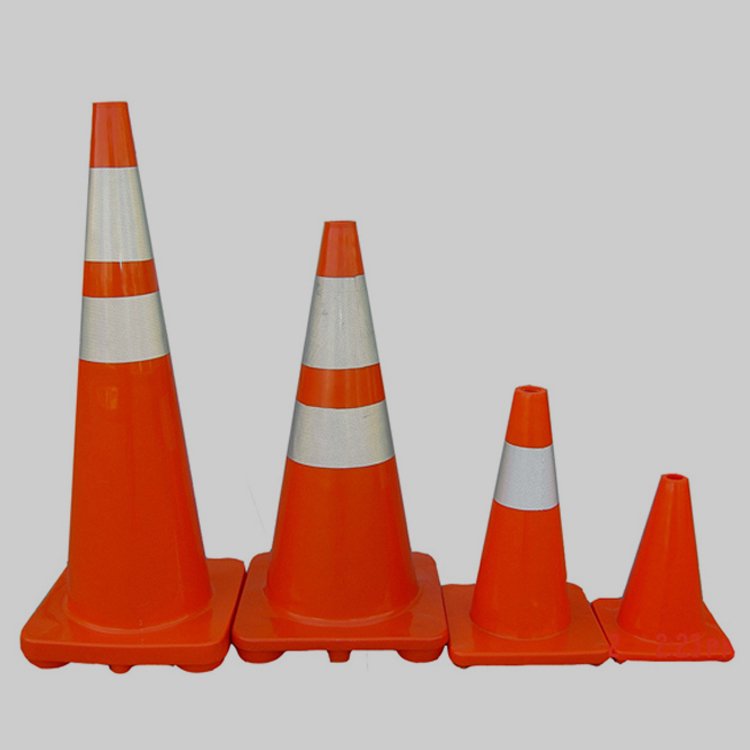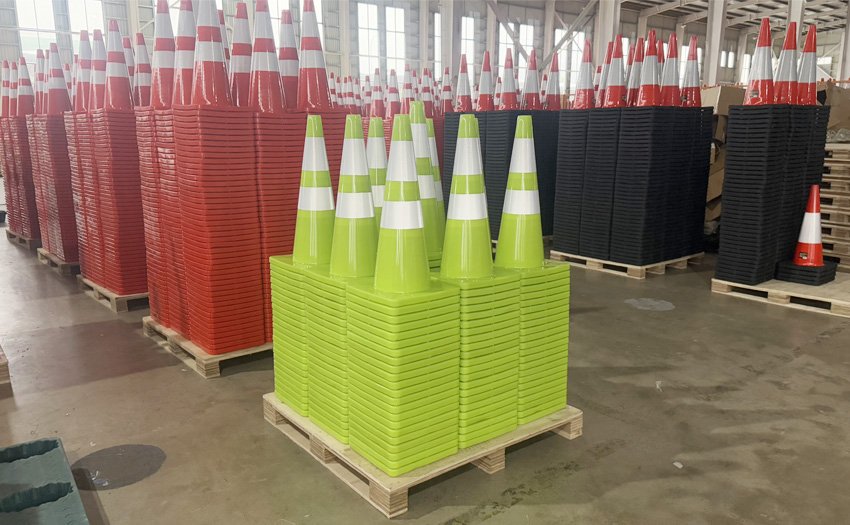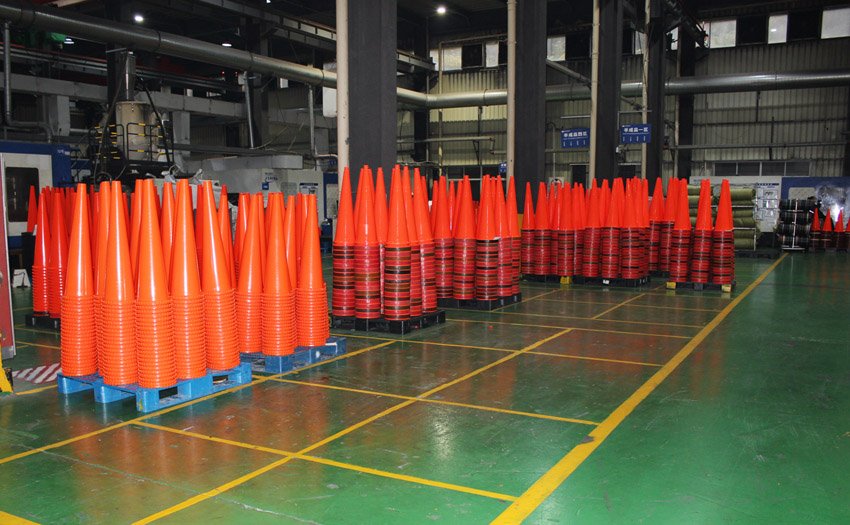The importance of traffic cones cannot be overstated, whether you are managing a construction site, assisting with a large event, or providing security for a parking lot. The right cone weight ensures stability and safety while adhering to regulations. Everything you need to know about how much a traffic cone weighs will be covered in this article, including typical cone sizes, materials, traffic cone dimensions, rules, and advice on how to choose the best cone for your requirements. 
Overview of Standard Weights of Traffic Cones
Road cones are available in a variety of weights and sizes to accommodate varying needs. They can direct pedestrians in parking lots or control traffic on highways. Every cone is routinely tested to a predetermined weight that balances strength, size, and visibility. The most popular sizes and average weights of small cones are listed here. Average Weight of Traffic Cones by Size


1. 12-inch cones: 2–3 lbs (ideal for indoor/light outdoor use)
These little cones are easy to transport and keep. Although they are useful for establishing crucial visual cues or boundaries, they are not appropriate for roadways or windy areas. Because they weigh less, they are more prone to topple over while they are outside.
Weight Range:
2 to 3 pounds
Applications:
- School hallways
- Shopping malls
- Indoor warehouses
- Temporary event setups
2. 18-inch cones: 4–6 lbs (common for roadwork)
These 18-inch cones are ideal for low-intensity outdoor use because they are slightly heavier and more stable than the 12-inch ones. However, despite being frequently observed in areas where cars move slowly, they might not function well in areas with high traffic or strong winds.
Weight Range:
4 to 6 pounds
Applications:
- Parking lots
- Drive-through lanes
- Service stations
- Residential street repairs
3. 28-inch cones: 7–10 lbs (high-visibility, moderate traffic)
The most popular size for maintaining routes is the 28-inch cone. Because of its size and weight, it is easily visible to drivers, and it is strong enough to withstand moderate wind. The reflective collars on the majority of 28-inch cones meet the specifications outlined in the Manual on Uniform Traffic Control Devices (MUTCD) and the Department of Transportation (DOT).
Weight Range:
7 to 10 pounds
Applications:
- The streets and pedestrian crossings in the city
- Sites for construction
- The location where the schools meet
- Locations for road repairs
4. 36-inch cones: 10–20 lbs (heavy-duty for highways)
These 36-inch cones are made to withstand harsh environments and are considered heavy-duty traffic cones. They are easily observable from a distance because of their height, particularly for swiftly moving vehicles. Because these cones are sometimes weighted with sand or solid bottoms to prevent them from toppling over, they are ideal for use in windy or hazardous conditions.
Weight Range:
10 to 20 pounds
Applications:
- Interstate highways
- Freeways
- Major infrastructure repair projects
- Toll plazas
Traffic Cone Types and Their Weights Overview
How many traffic cones are there in the world? We will explore it in this brief table.
| Type | Typical Weight Range | Best For |
| Standard Stackable
Collapsible (Pop-Up) Reflective Cones Weighted Base Cones Mini/Indoor Safety Cones |
|
|
Why Traffic Cone Weight Varies Within Each Size Range
Instead of having a single, predetermined number, each measurement will have a range of potential weights.
- Elasticity, thermoplasticity, and the type of material (PVC against other materials) all affect this sort.
- Presence of reflective collars nearby
- A foundation that may be a weighted or hollow base design
- There are extra features, including lights or handles.
For instance, a 28-inch-diameter cone constructed of sturdy plastic will weigh more than a hollow PVC cone with a detachable base, even if the two cones are the same height. Whether the cone must be able to withstand wind on a road or be lightweight enough to be carried about a warehouse, its weight must be carefully chosen to guarantee that it performs as intended. Sustaining a healthy weight promotes stability, security, and conformity to social expectations.
Why the Weighted Traffic Cone Matters
- Stability and Resistance to Wind: Heavier Cones are less prone to topple over due to wind or oncoming traffic. This is particularly crucial in fast-paced or windy situations.
- Safety Guidelines and Standards: Minimum weight limitations for specific acts are regularly established by agencies such as OSHA and the DAB. In addition to creating problems, using too-light cones might be hazardous.
- Transporting and Utilizing: Heavy cones are more sturdy, but using them is more challenging. Lighter cones are simple to use and set up for temporary installations.
Weighted Safety Cones Regulatory Guidelines and Standards
Traffic cones must adhere to stringent specifications in order to be safe and effective.
- (Division of Transportation) Cones used on highways must meet certain weight and dimension requirements set by the State.
- OSHA, the Occupational Safety and Health Administration, establishes safety regulations for construction sites and workplaces.
- The MUTCD (Manual on Uniform Traffic Control Devices) controls the color, height, and weight of cones to ensure that they are visible and functional.
- The European Standard EN 13422 regulates the base weight and strength of cones in EU countries.
How to Choose the Right Weight for Your Needs
Think about the following before selecting a cone for any purpose:
- Is it outdoors or indoors? Use lighter cones indoors and heavier ones outdoors when it is windy.
- Temporary vs. Permanent Setup: Long-term projects require strong, durable cones, while temporary and short-term events benefit from light, movable cones.
- Transport and Capacity: While lighter cones are simpler to manage and stack, larger cones could require specialized transportation.

JACKWIN Your Customized Weight Cone Traffic Partner
At Jackwin, we understand that a single weight size may not satisfy everyone. Whether it is for event management, a construction project, or warehouse safety, we place a high priority on designing customized traffic cone weights that meet your unique needs. You can pick from our custom variety of sizes and weights.
We are a customized traffic cone manufacturer and offer cones in sizes ranging from 12 to 36 inches, and custom sizes are also available. Select from PVC, flexible materials, and eco-friendly substitutes to meet your needs for durable and environmentally friendly products. Depending on your company’s needs, decide on your colors, logo, and whether you want smart pieces or substantial bases. Jackwin, as a wholesale traffic cone supplier, meets all traffic cone safety standards and quality standards established by the MUTCD, OSHA, and DOT.

Conclusion
There is more to choosing the right weight for a traffic cone than just picking the heaviest or least expensive one. It involves figuring out the best plan of action for the application you have in mind. Think about things like how the wind impacts it, following the instructions, and making sure it is easy to use. Knowing the cones’ weight is essential for conducting activities safely, regardless of whether you require big cones for busy highways or small cones for quick events. Searching for traffic cone OEM services? Jackwin, as a traffic safety product manufacturer, can help you design traffic cone arrangements that are specific to your needs and comply with regulations. Contact us today for further information!


-80x69.png)

